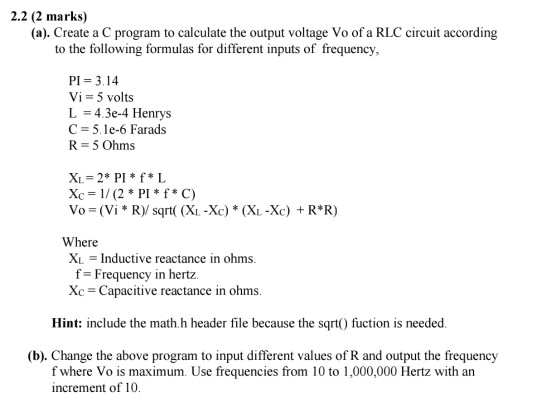Question
I have finished 2.a), Im just confused with 2.b) we need to use a for loop to compare the different frequencies and Vo until we

I have finished 2.a), Im just confused with 2.b) we need to use a for loop to compare the different frequencies and Vo until we reach the maximum number. I'll include the code for 2.a)
# include
return 0;
}
2.2 (2 marks) (a). Create a C program to calculate the output voltage Vo of a RLC circuit according to the following formulas for different inputs of frequency, PI = 3.14 Vi= 5 volts L = 4.3e-4 Henrys C = 5. le-6 Farads R= 5 Ohms XL=2* P*f*L Xc = 1/(2* PI* f* C) Vo=(Vi* R/ sqrt(XL-Xc) * (XL-Xc) +R*R) Where XL = Inductive reactance in ohms. f Frequency in hertz. Xc = Capacitive reactance in ohms. Hint: include the math.h header file because the sqrt() fuction is needed (b). Change the above program to input different values of R and output the frequency f where Vo is maximum. Use frequencies from 10 to 1,000,000 Hertz with an increment of 10Step by Step Solution
There are 3 Steps involved in it
Step: 1

Get Instant Access to Expert-Tailored Solutions
See step-by-step solutions with expert insights and AI powered tools for academic success
Step: 2

Step: 3

Ace Your Homework with AI
Get the answers you need in no time with our AI-driven, step-by-step assistance
Get Started


